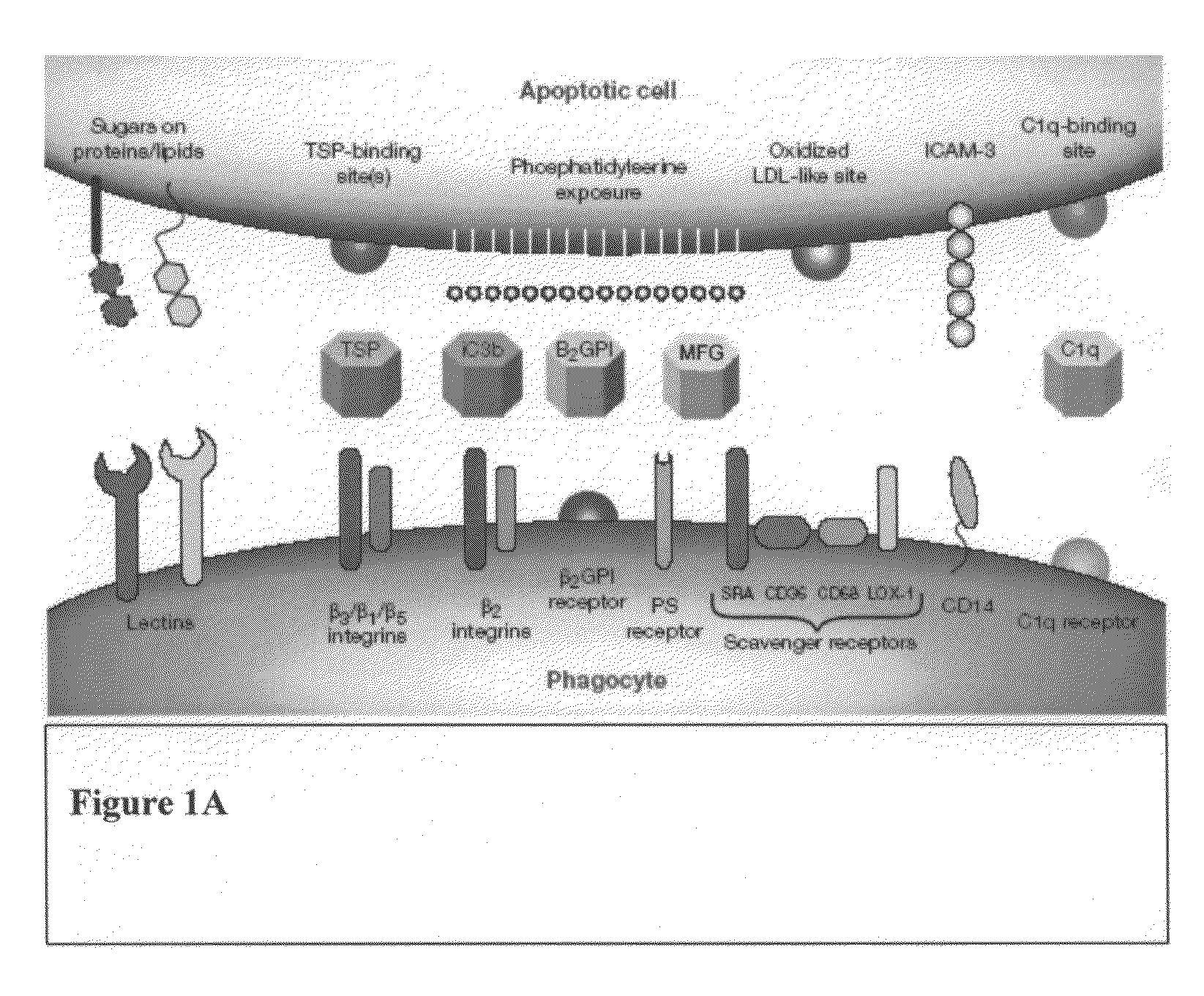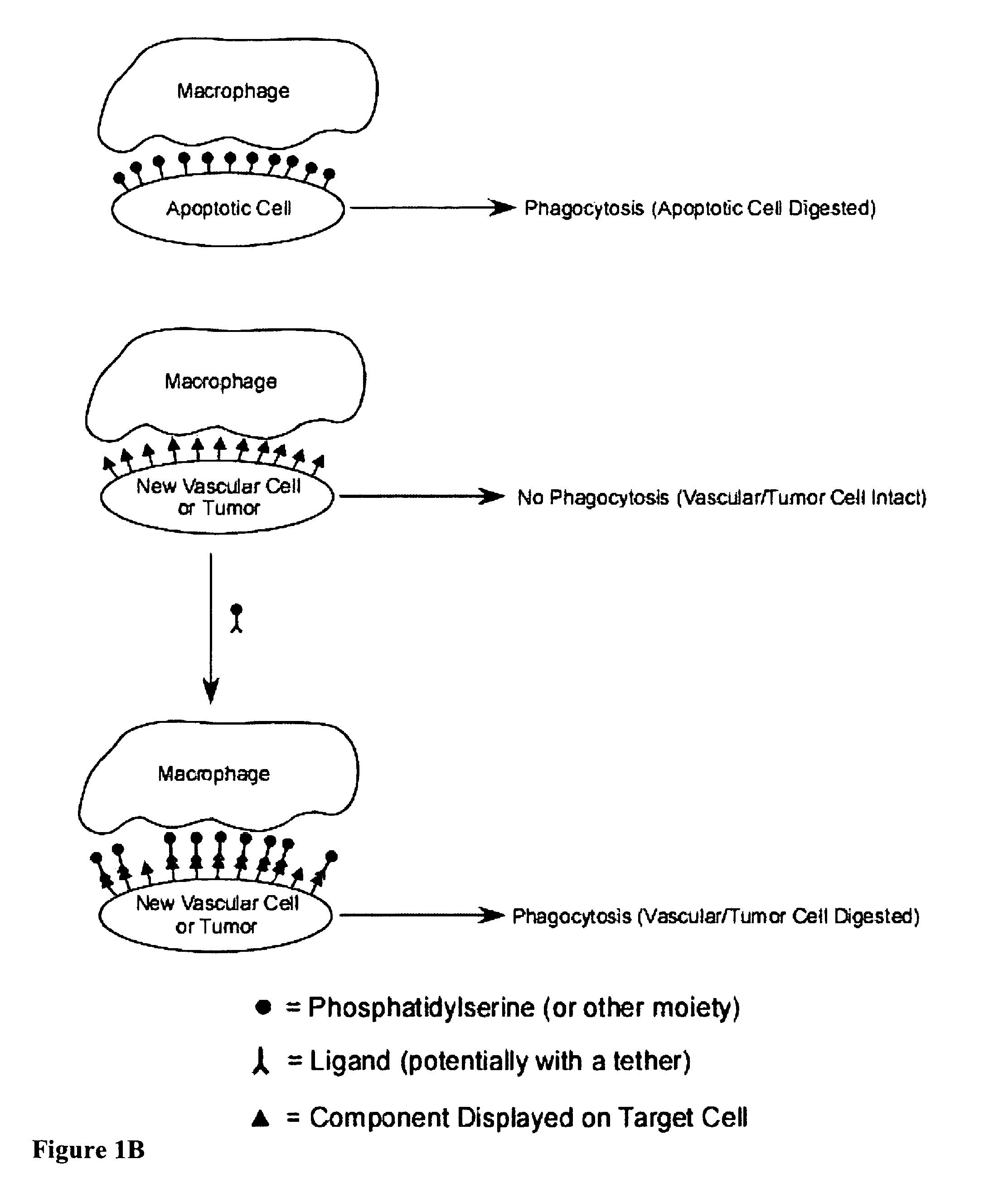Compositions and methods for enhancing phagocytosis or phagocyte activity
a phagocytosis and phagocyte technology, applied in the direction of liposomal delivery, depsipeptides, peptide/protein ingredients, etc., can solve the problems of insufficient immune surveillance to prevent cancer, insufficient body's own mechanisms for detecting and removing cells, and often insufficient harmful noncellular molecular entities, etc., to achieve better targets for phagocytosis, enhance or incite phagocytosis
- Summary
- Abstract
- Description
- Claims
- Application Information
AI Technical Summary
Benefits of technology
Problems solved by technology
Method used
Image
Examples
example 1
Enhancement of Phagocytosis by a PS Derivative
[0297]Materials and Methods
[0298]Cells and Cell Culture.
[0299]Human umbilical vein endothelial cells (HUVECs) and MonoMac-1 cells (a human myeloma cell line) were obtained from Cambrex Inc., East Rutherford, N.J., and were maintained under standard culture conditions. Both cell lines are adherent under these culture conditions.
[0300]Compound Synthesis.
[0301]The phosphatidylserine derivative shown in FIG. 4C, containing a PS headgroup, was synthesized according to the scheme shown in FIG. 4A, which is described above. The commercially available phosphatidylcholine derivative 1-Hexanoyl-2-Hydroxy-sn-Glycero-3-Phosphocholine (Cat. No. 855175 Avanti Polar Lipids, Alabaster, Ala.) was used, resulting in a compound in which R is a 5 carbon chain. The PS derivative reacts with free thiols in proteins on the cell surface. In other experiments, the phosphatidylcholine derivative 1-Myristoyl-2-Hydroxy-sn-Glycero-3-Phosphocholine or 1-Tetradecanoyl...
example 2
Synthesis of an MGF-E8-Streptavidin Fusion Protein
[0316]MFG-E8 (GenBank: NM—0045928) is a protein of 387 amino acids. Two splicing variants of this protein exist, an S form and an L form. While they differ only by a proline-rich motif present in the L form, the L form has been demonstrated to be more active and is used here.
[0317]Obtaining MFG-E8 cDNA. Human MFG-E8 is obtained by PCR from a first-strand cDNA library obtained from human fetal spleen tissue (BD Clonetics). An epitope tag (FLAG) is then incorporated into the N-terminal part of the protein between the signal peptide (amino acid residues 1-22) and the first EGF-like domain (amino acid residues 24-61). This tag can be used for monitoring protein expression by Western analysis and for purification with the use of anti-FLAG antibodies and anti-FLAG M2 affinity gel (Sigma) respectively.
[0318]Fusing MFG-E8 with SAV. Fusing MFG-E8 to SAV (GenBank: X03591) should provide MFG-E8 with the ability to bind cells that have been surf...
example 3
Effect of MFG-E8 Derivatives on Phagocytosis
[0322]This example describes assessment of the ability of two different MFG-E8 derivatives to enhance phagocytosis of target cells in vitro. The target cells used here are endothelial precursor cells (EPCs) (101). These cells exhibit a gene expression profile more similar to that of cells isolated from fresh surgical specimens of human tumors than HUVECs and may thus be preferable for use in such assays. In addition, the phagocytic cells are human blood-derived (HBD) macrophages rather than MonoMac-1 s.
[0323]Preparation of EPC and macrophage cell cultures. EPCs are prepared as described by Bagley et al (101). CD34+ / AC133+ progenitor cells from human bone marrow cells will be purchased from Cambrex. They will be grown at 1-2×105 cells / ml in IMDM medium (Cambrex) supplemented with 15% FBS (Invitrogen Corp., Carlsbad, Calif.), 50 ng / ml VEGF165 (R&D Systems, Minneapolis, Minn.), 50 ng / ml rhbFGF (R&D Systems), and 5 units / ml heparin (Sigma, St....
PUM
| Property | Measurement | Unit |
|---|---|---|
| MW | aaaaa | aaaaa |
| Volume | aaaaa | aaaaa |
| Volume | aaaaa | aaaaa |
Abstract
Description
Claims
Application Information
 Login to View More
Login to View More - R&D
- Intellectual Property
- Life Sciences
- Materials
- Tech Scout
- Unparalleled Data Quality
- Higher Quality Content
- 60% Fewer Hallucinations
Browse by: Latest US Patents, China's latest patents, Technical Efficacy Thesaurus, Application Domain, Technology Topic, Popular Technical Reports.
© 2025 PatSnap. All rights reserved.Legal|Privacy policy|Modern Slavery Act Transparency Statement|Sitemap|About US| Contact US: help@patsnap.com



